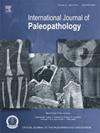意大利东北部Olmo di Nogara青铜时代中期墓地出土的一例严重的双侧肱骨屈曲畸形病例。生物力学分析对古病理学研究的贡献
IF 1.5
3区 地球科学
Q3 PALEONTOLOGY
引用次数: 0
摘要
材料一具来自意大利 Olmo di Nogara 的 40-50 岁男性骸骨,与来自同一墓地的其他男性骸骨以及意大利新石器时代和铁器时代的样本进行了比较。方法显微镜/X 射线分析进行病理诊断和横截面几何分析。结果该个体的双侧肱骨显得短小,肱骨头遭到破坏,显示出严重的骨关节病,肩胛骨盂腔变平。该患者的肱骨双侧明显不对称;没有证据表明其肱骨受到过持续固定。意义生物力学分析提供了一个有用的工具来重建该受试者在社区中的生活,表明该受试者明显的上肢畸形并没有使他摆脱战士的角色,并强调了战士身份在这个青铜时代社会中的重要性。局限肱骨骨骺损伤和肱骨缩短之间复杂的相互作用使评估活动模式变得困难。对进一步研究的建议横断面几何学可用于其他肱骨变曲或骨发育不良病例,以调查功能障碍。本文章由计算机程序翻译,如有差异,请以英文原文为准。
A severe case of bilateral humerus varus deformity from the Middle Bronze age necropolis of Olmo di Nogara, Northeast Italy. The contribution of biomechanical analysis to paleopathological study
Objective
To gain insights on possible impairment of a Middle Bronze Age individual with bilateral humerus varus buried with a sword in Northeastern Italy.
Materials
A skeleton of a 40–50-year-old male from Olmo di Nogara (Italy) compared to other males from the same necropolis and to Neolithic and Iron Age samples from Italy.
Methods
Macroscopic/X-rays analysis for pathological diagnosis and cross-sectional geometric analysis.
Results
Both humeri of the individual appear short with destruction of the humeral heads, showing severe osteoarthrosis and flattening of the scapular glenoid cavities. The individual showed appreciable humeral bilateral asymmetry; there is no evidence for sustained immobilization.
Conclusions
The pathological modifications suggest a diagnosis of bilateral humeral varism probably following an injury at birth. The individual’s life was likely not significantly affected, as evidence suggests that he remained active and possibly used weapons.
Significance
Biomechanical analyses provided a useful tool to reconstruct the life of the subject within the community, showing that this individual’s apparent upper limb abnormalities did not exempt him from a role as a warrior and highlighting the importance of the warrior identity in this Bronze Age society.
Limitations
The complex interaction between epiphyseal damage and shortening of the humerus makes it difficult to assess activity patterns. Only severe impairment leading to long-term immobilization can be excluded for this individual.
Suggestions for Further Research
Cross-sectional geometry may be used in other cases of humerus varus or bone dysplasia to investigate functional impairment.
求助全文
通过发布文献求助,成功后即可免费获取论文全文。
去求助
来源期刊

International Journal of Paleopathology
PALEONTOLOGY-PATHOLOGY
CiteScore
2.90
自引率
25.00%
发文量
43
期刊介绍:
Paleopathology is the study and application of methods and techniques for investigating diseases and related conditions from skeletal and soft tissue remains. The International Journal of Paleopathology (IJPP) will publish original and significant articles on human and animal (including hominids) disease, based upon the study of physical remains, including osseous, dental, and preserved soft tissues at a range of methodological levels, from direct observation to molecular, chemical, histological and radiographic analysis. Discussion of ways in which these methods can be applied to the reconstruction of health, disease and life histories in the past is central to the discipline, so the journal would also encourage papers covering interpretive and theoretical issues, and those that place the study of disease at the centre of a bioarchaeological or biocultural approach. Papers dealing with historical evidence relating to disease in the past (rather than history of medicine) will also be published. The journal will also accept significant studies that applied previously developed techniques to new materials, setting the research in the context of current debates on past human and animal health.
 求助内容:
求助内容: 应助结果提醒方式:
应助结果提醒方式:


